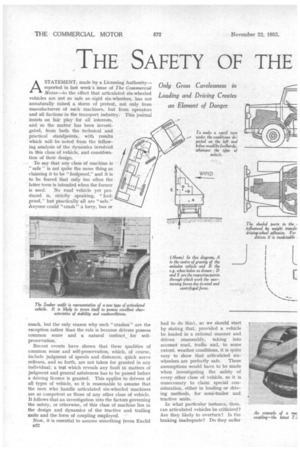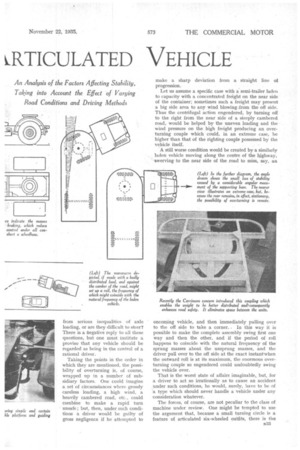THE SAFETY OF THE
Page 42

Page 43

Page 44

If you've noticed an error in this article please click here to report it so we can fix it.
i.RTICULATED VEHICLE ASTATEMENT, made by a Licensing Authority— reported in last week's issue of The Commercial Motor—to the effect that articulated six-wheeled vehicles are not so safe as rigid six-wheelers, has not unnaturally raised. a storm of protest, not only from manufacturers: of such machines, but from operators and all factions-in the transport industry. This journal insists on fair play for all interests, and so the matter has been investigated, from both the technical and practical standpoints, with results which will be noted from the following analysis of the dynamics involved in this class of vehicle, and consideration of their design.
To say that any class of machineis "safe" is not quite the same thing as claiming it to be "foolproof," and it is to be feared that only too often the latter term is intended when the former is used. No road vehicle yet produced is, strictly speaking, "foolproof,'' but practically all are "safe." Anyone could "crash" a lorry, bus or coach, but the only reason why such "crashes" are the exception rather than the rule is because drivers possess common sense and a natural instinct_ for selfpreservation.
Recent events have shown that these qualities of common sense and self-preservation, which, of course, include judgment of speeds and distances, quick nerve reflexes, and so forth, are not taken for granted in any individual; a test which reveals any fault in matters of judgment and general astuteness has to be passed before a driving licence is granted. This applies to drivers of all types of vehicle, so it is reasonable to assume that the men who handle articulated six-wheeled machines are as competent as those of any other class of vehicle. It follows that an investigation into the factors governing the safety, or otherwise, of this class of machine lies in the design and dynamics of the tractive and trailing units and the form of coupling employed.
Now, it is essential to assume something (even Euclid had to do this), so we should start by stating that, provided a vehicle be loaded in a rational manner and driven reasonably, taking into account road, traffic and, to some extent, weather conditions, it is quite easy to show that articulated sixwheelers are perfectly safe. These assumptions would have to be made when investigating the safety of every other class of vehicle, so it is unnecessary to claim special consideration, either in loading or driving methods, for semi-trailer and tractive units.
In what particular instance, then, can articulated vehicles be criticized? Are they likely to overturn? Is the braking inadequate? Do they suffer from serious inequalities of axle loading, or are they difficult to steer? There is a negative reply to all these questions, but one must institute a proviso that any vehicle should be regarded as being in -the control of a rational driver.
Taking the points in the order in which they are mentioned, the possibility of overturning is, of course, wrapped up in a number of subsidiary factors. One could imagine a set of circumstances where grossly careless loading, a high wind, a heavily cambered road, etc., could combine to make a rapid turn unsafe; but, then, under such conditions a driver would be guilty of gross negligence if he attempted to make a sharp deviation from a straight line of progression.
Let us assume a specific case with a semi-trailer laden to capacity with a concentrated freight on the near side of the container; sometimes such a freight may present a big side area to any wind blowingifrom the off side. Thus the centrifugal action engendered, by turning off to the right from the near side of a steeply cambered road, would be helped by the uneven loading and the • wind pressure on the high freight producing an overturning couple which could, in an extreme case, be higher than that of the righting couple possessed by the vehicle itself.
A still worse condition would be created by a similarly laden vehicle moving along the centre of the highway, 'swerving to the near side of the road to miss, say, an oncoming vehicle, and then immediately pulling over to the off side to take a corner.. In this way it is possible to make the complete assembly swing first one way and then the other, and if the period of roll happens to coincide with the natural frequency of the sprung masses about the unsprung masses, and the driver pull over to the off side at the exact instant when the outward roll is at its maximum, the enormous overturning couple so engendered could undoubtedly swing the vehicle over.
That is the worst state of affairs imaginable, but, for a driver to act so irrationally as to cause an accident under such conditions, he would, surely, have to he of a type which should never handle a vehicle under any -consideration whatever.
The forces, of course, are not peculiar to the class of machine under review. One might be tempted to use the argument that, because a small turning circle is a feature of articulated six-wheeled outfits, there is the danger that drivers will use the full potentialities for making rapid turns on every occasion—an absurd assumption, of course.
It should be remembered that the hitch between the tractive and trailing units has to be somewhat " loose" in order to allow the towing vehicle and the semi-trailer io be coupled when operating on uneven ground. In this way the rigidity is somewhat impaired. In certain designs, however, provision is made to counteract this.
Turning now to the second :point, that of braking. Anyone who took the trouble to examine thoroughly the retarding mechanisms of the semi-trailers shown at Olympia, during the Commercial Motor Exhibition, could not help but be impressed by the thorough way in
which all work was carried out. Most of the larger semi-trailers are equipped with air or vacuum-servo brakes on the trailing wheels, the shoes being applied along with those of the tractive unit (operated by the same medium) when the pedal is depressed. Time lag, in these circumstances, is, of course, negligible, whilst the retarding effect is quite adequate and, at least, comparable with that of vehicles having rigid chassis.
The question of inequality of axle weights cannot be considered without taking into account the driver's influence. A heavy, concentrated load placed either at the forward end or the rear of the platform, or even on one side amidships, should not be tolerated, and any driver has powers to see that his vehicle is loaded in a reasonable manner. This does not mean that he should cavil at a few hundredweight of out-of-balance weight, but, to quote an example, he should make sure that a 6-ton 'article is not dumped, say, immediately in front of the tailboard, when adhesion of the driving wheels would be seriously affected.
Except when running backwards, articulated six-. wheelers are just as easy to steer as any other type of machine and the turning effort on the wheel is moderate. In certain classes of vehicle produced recently a specially low-geared steering system has been used, not only to reduce driving fatigue but also absolutely to prevent absurdly sharp turns being executed, because a time element is introduced which has the effect of frustrating the foolish actions of an inexpert driver.
Before concluding, it might be opportune to consider the operation of tractive units when used unattached. In this case, a different set of conditions altogether is encountered. In the first place, the tractors are, in effect, nothing more than chassis, a reasonably short wheelbase usually being employed in order to allow the longest possible freight container to be used.
A very short layout can be achieved by placing the engine and cab well forward, but there is a disadvantage to this design as the weight transference under braking conditions is naturally fairly high, and lateral stability is likely to be lost owing to the decrease in adhesion of the rear wheels. Thus one finds that nearly all contemporary tractive units have a reasonably long wheelbase with normal control, making the machine perfectly safe to handle when separated from the trailer. The dynamics of three-wheeled units differ, of course, somewhat from those of the four-wheeled type, but many of the remarks apply with equal force to both.
Summed up, then, the case against articulated sixwheelers can only be made if a vehicle be badly loaded and driven with gross negligence, terms which apply with equal force to any other class of road vehicle.




















































































